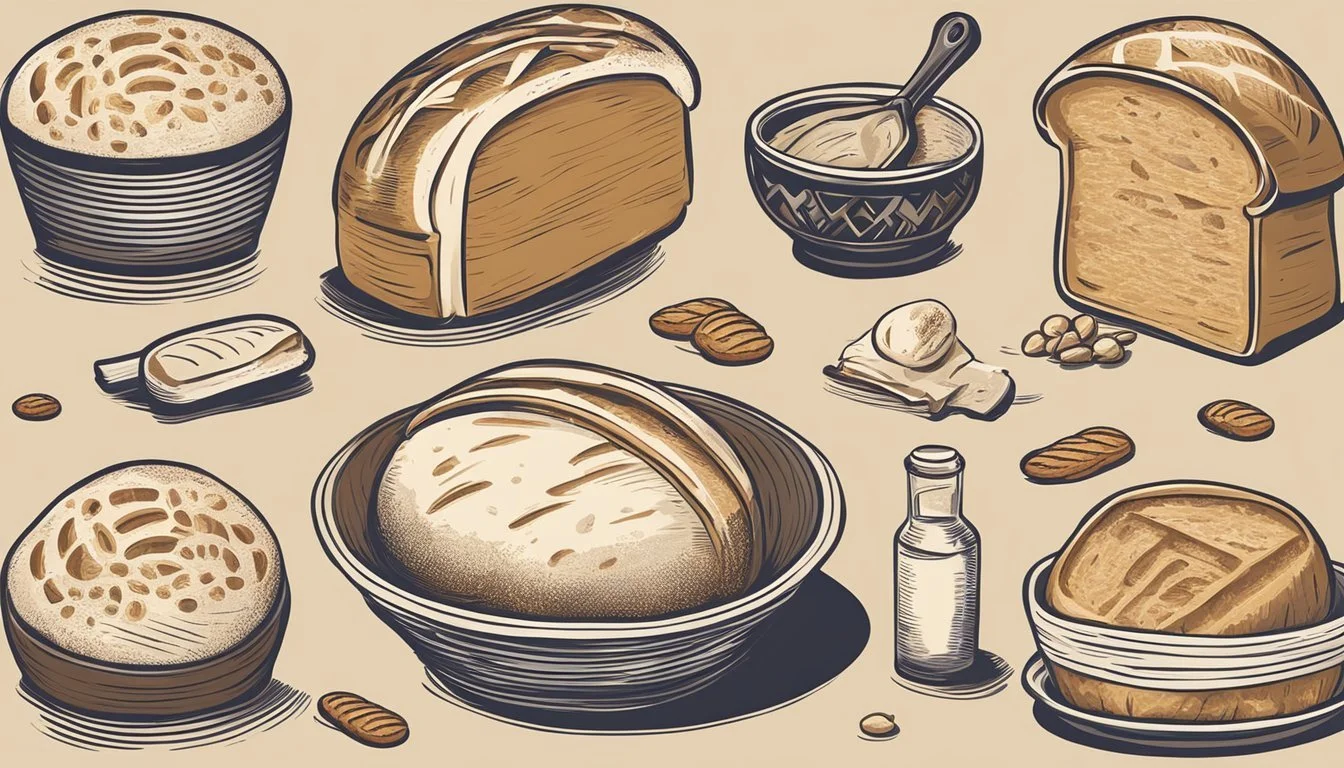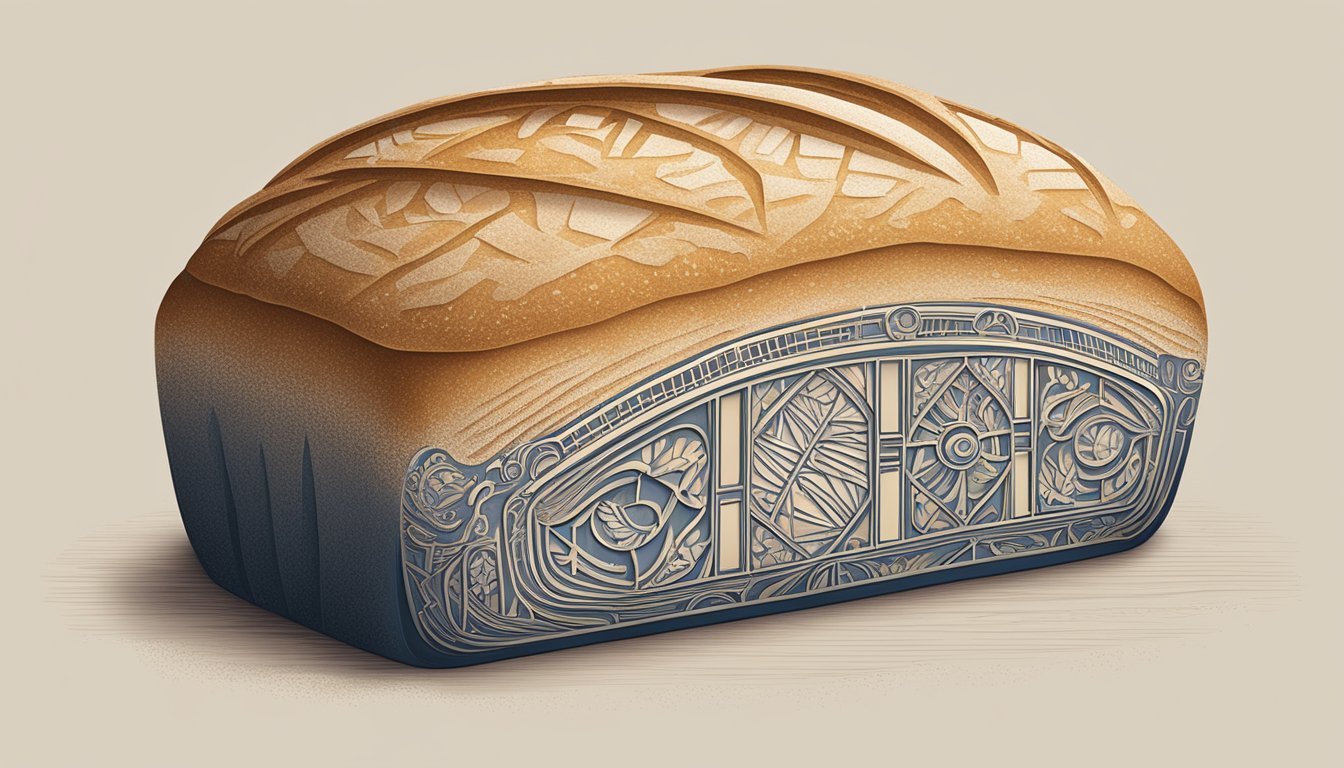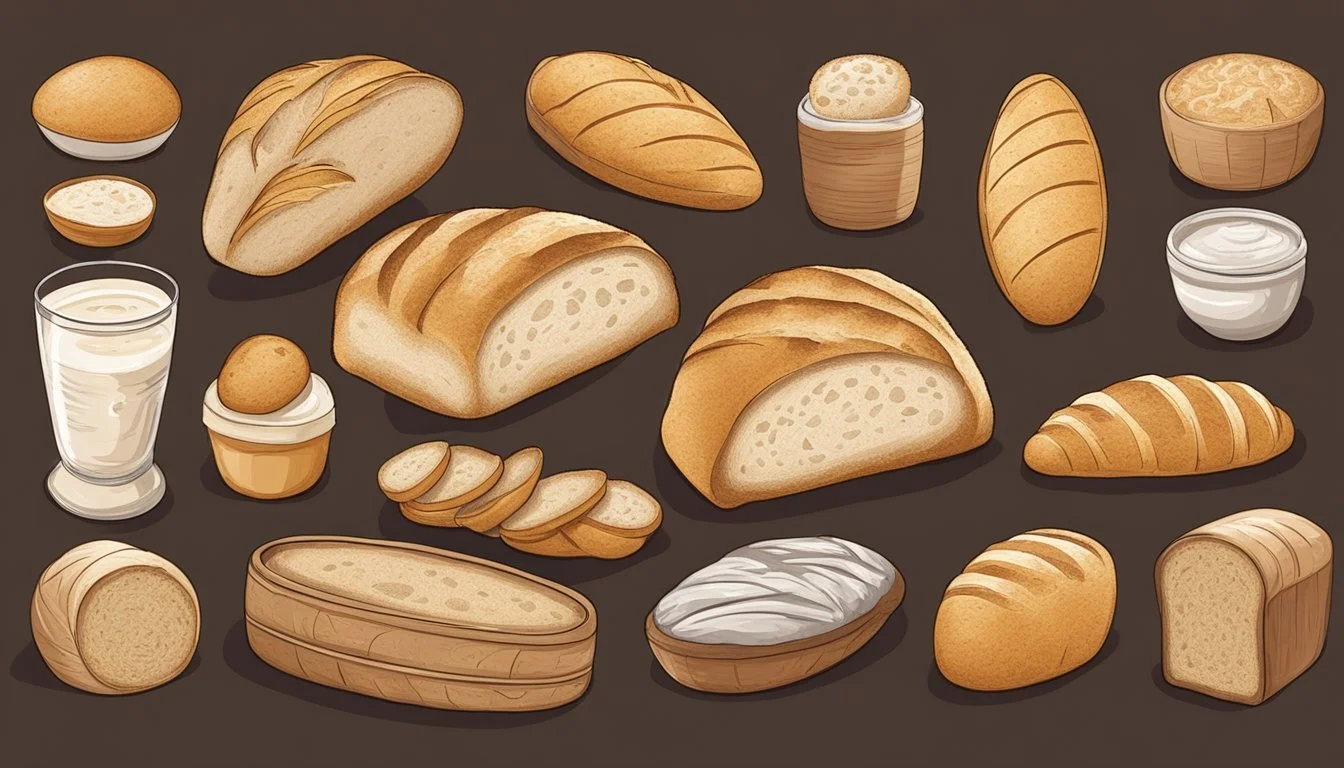Sourdough Bread Scoring Symbols and Their Meanings
A Guide to Artisanal Designs
Scoring sourdough bread before baking is not just a means to add aesthetic appeal to the crust. It's a vital step in the baking process that allows the dough to properly expand in the oven, creating the desired shape and texture. These intentional cuts made on the surface of the dough can vary in depth and pattern, each playing a role in influencing the final appearance and quality of the bread. Above all, they serve as bakers' signatures, with each pattern holding its own traditional or personal meaning.
Sourdough enthusiasts often look beyond the practical aspects of bread scoring to the symbolism etched onto their loaves. While some patterns are chosen for their simplicity and functionality, others carry a piece of history or cultural significance. Symbols can indicate the type of bread, signify special occasions, or simply reflect the baker's creativity. As bakers become more adept at handling the dough and blade, the scoring symbols become more intricate, telling a story or capturing a moment in time through each loaf.
Understanding the various scoring symbols and their meanings adds depth to the appreciation of sourdough bread. Each cut, from the single bold slash to complex geometric designs, is a decision made with purpose. The baker's experience and intent transform the humble ingredients of flour, water, and salt into an edible canvas, where the language of scoring speaks to both the baker's skill and the bread's potential.
The Basics of Sourdough Scoring
Scoring sourdough bread is a critical step in bread-making that ensures proper expansion and contributes to the final appearance of the loaf. Mastery of this technique allows bakers to predict the bread's oven spring and enhance its aesthetic appeal.
Purpose of Scoring Sourdough Bread
Scoring is the process of making shallow or deep cuts on the surface of sourdough before baking. These cuts serve several vital functions:
Controlled Expansion: The primary reason bakers score their bread is to direct the final expansion of the loaf as it bakes. This is known as "oven spring," and scoring provides the dough with a weak point to open in a controlled manner.
Aesthetic Design: In addition to its functional role, scoring can also be used to add decorative patterns to the bread, allowing bakers to identify different loaves or simply create beautiful, unique designs.
Gas Release: Scoring allows for the gases produced during fermentation to escape without rupturing the crust or deforming the loaf.
Tools for Scoring
The right tools are essential for effective scoring. A lame, which is a handle that typically holds a razor blade, is the preferred tool of most artisan bakers due to its sharpness and precision. There are two main types of blades used for scoring: straight blades and curved blades. Each type plays a specific role:
Straight Blade: A straight blade creates clean, straight cuts and is great for making slashes that encourage the dough to rise upwards.
Curved Blade: Conversely, a curved blade is ideal for more intricate designs and patterns, as it allows the cut to open more gracefully during the baking process.
Using a sharp blade is critical; it should effortlessly glide through the dough without dragging. A dull blade can snag the dough, leading to uneven expansion and an unattractive appearance.
Here are recommended tool options and their uses:
Tool Description Use Lame A handle fitted with a sharp razor blade Scoring designs with precision Razor Blade A disposable straight or curved blade When a standalone blade is preferred for scoring Bread Lame A specialized lame designed for bread scoring Curved or straight patterns, equipped with a comfortable grip
In all cases, whether using a bread lame or a simple razor blade, the goal is the same: to incise the dough in a manner that maximizes the loaf's potential for an even rise and desired appearance.
Scoring Techniques
Scoring sourdough bread is an essential step in the baking process, affecting not only the bread's appearance but also its structural integrity during baking. Techniques vary depending on the desired outcome in terms of aesthetics and loaf expansion.
Scoring Patterns and Designs
Straight Slash: A single long cut often results in a pronounced “ear,” a raised crust along the cut's edge.
Cross: Two straight slashes that intersect are traditional and practical, guiding even expansion.
Wheat Stalk: Multiple curved cuts that mimic a wheat stalk, combining both beauty and function, managing the bread's expansion.
Checkerboard: A series of perpendicular cuts that create a patterned look and manage bloom.
Curves and Spirals: Circular cuts that unfold into attractive designs and allow for controlled rise.
Depth and Angle of Scoring
Depth:
Shallow (Around 1/4 inch): Yields a more delicate expansion.
Moderate (1/2 inch): Ideal for most loaves, achieving an optimal balance.
Deep (Up to 1 inch): Creates significant openings, influencing the bread's final shape significantly.
Angle:
Shallow Angle (20-30 degrees): Supports the formation of an “ear” and directs upward expansion.
Vertical Cut (90 degrees): Encourages bread to open broadly with less upward lift.
Each scoring technique influences the sourdough's crust appearance and interior crumb structure. The depth and angle of scoring are vital for the bread's structural integrity, allowing gas to escape and the loaf to expand correctly during baking.
Artistic Scoring and Creativity
Artistic scoring in sourdough bread transforms the loaf from a mere baked good into an edible canvas, where creativity is expressed through intricate patterns and symbolic cuts. These decorative scores not only serve an aesthetic purpose but are also a functional aspect that controls the bread’s expansion during baking.
Popular Symbols and Their Meanings
Leaves: Often symbolizing growth and nature, leaves are a common choice for scoring, connecting the bread to organic origins.
Stars: The star is used for its eye-catching appeal, perhaps hinting at a baker's aspiration for perfection or excellence.
Flowers: Floral patterns can signify blooming and freshness, resonating with the idea of natural ingredients blossoming into a final product.
Animals: Animal shapes in scoring might reflect the baker's personal interests or are used to convey a specific theme or celebration.
Shapes: Geometric shapes such as circles, triangles, and squares can introduce a modern aesthetic or symbolize stability and order.
Intricate and Decorative Scoring
Intricate decorative scoring requires precision and a steady hand to create complex designs like mandalas, which can represent balance and unity. Bakers often infuse personal creativity into:
Artistic Scores: These deliberate cuts turn the dough's surface into a platform for personalized art, allowing bakers to infuse meaning into each loaf.
Decorative Cuts: From simple crisscross patterns to elaborate landscapes, each incision is thoughtfully planned to enhance both the loaf's beauty and structural integrity.
Preparation and Proofing for Scoring
Proper preparation and proofing are essential for optimal scoring results; they set the stage for the dough's final appearance and texture post-bake.
Final Dough Proofing
The final proof is where the dough undergoes its last rise before baking, a crucial step that directly influences scoring outcomes. Bakers should allow the dough to proof until it nearly doubles in size but retains enough tension to hold its shape. It's during this stage that the dough's flavor and crumb structure finalize.
Ideal proofing time varies depending on temperature, dough composition, and the desired end structure.
Utilizing a proofing basket or banneton helps maintain the dough's structure and provides a supportive environment for that crucial rise.
For those preferring a cold dough, retarding the proof in a refrigerator can enhance flavor development and firm up the dough, aiding in cleaner scoring.
Dough Surface Tension and Treatment
Maintaining the right surface tension on the dough is integral. It ensures that scores open effectively during baking. A tighter surface prevents the dough from collapsing when scored and shall produce distinct symbols.
Tension is created by shaping the dough properly and sealing seams tightly.
To prevent the dough from sticking to the scoring tool, a thin layer of rice flour can be applied. Unlike wheat flour, rice flour doesn't bake into the dough and will instead keep the scored pattern pronounced.
Oil is not commonly used in sourdough scoring as it can interfere with the formation of a crisp skin, an aspect that is critical for well-defined scoring.
Baking and Oven Considerations
In sourdough bread baking, understanding the influence of the oven on the final bread's shape and texture is critical. Proper control of oven spring and steam, along with preheating techniques, directly impact the expression of scoring patterns and the quality of the crust.
Oven Spring and Steam Generation
Oven spring is the rapid rise of dough during the initial stage of baking due to heat causing further expansion of gases. To achieve a pronounced oven spring, the injection of steam is essential within the first few minutes of baking. Steam makes the dough surface flexible, allowing the bread to expand freely and the scoring symbols to bloom properly. Bakers often employ a Dutch oven to trap moisture close to the loaf, or they introduce water into the oven in various ways to generate steam.
Methods for Adding Steam:
Pour boiling water into a preheated pan at the bottom of the oven.
Place ice cubes on a preheated tray to create steam as they melt.
Use a spray bottle to mist the walls of the oven, avoiding the light bulb and glass door.
Preheating and Baking Surfaces
Preheating is a critical step: A consistently high oven temperature is required for successful bread baking, usually between 450°F and 500°F. This ensures robust oven spring and optimal heat transfer to the dough. Baking surfaces also contribute to heat distribution and crust development.
Recommended Baking Surfaces:
Dutch oven: Retains heat and ensures even baking.
Baking stone: Mimics a hearth oven, transferring heat quickly to the dough.
Steel: Conducts heat even more efficiently than a stone.
Bakers often line their chosen baking surface with parchment paper for easy transfer of the dough and to prevent sticking. Preheat the baking surface along with the oven to ensure immediate heat transfer to the dough for a better rise and a crispier crust.
Troubleshooting Common Scoring Mistakes
Scoring sourdough bread requires precision and an understanding of dough characteristics. This section explores how to rectify common mistakes that can adversely affect the final bake, focusing on dough handling and proper fermentation indicators.
Blowouts and Underproofing
Blowouts are the result of the gas inside the dough finding the path of least resistance during baking. This typically suggests the bread has not been scored deeply enough or is underproofed.
Symptoms: Bulging sides, irregular shapes.
Solutions:
Ensure sufficient depth while scoring, aiming for at least 1/4 inch.
Allow longer fermentation times if the dough feels firm and dense.
Handling of Wet Dough and Stickiness
Wet dough can lead to stickiness, which complicates scoring as the blade may drag and pull the dough.
Symptoms: Dough clinging to hands or blade, uneven scores.
Solutions:
Dust the surface of the dough lightly with flour prior to scoring.
Use a sharp blade and swift, confident strokes to minimize drag.
Maintenance and Care of Scoring Tools
Proper maintenance of scoring tools is essential for clean cuts and the longevity of the equipment. Thorough cleaning and correct storage prevent rust and damage, while regular sharpening ensures optimal performance during scoring.
Cleaning and Storing Lames and Blades
Cleaning
After each use, lames and blades should be wiped with a damp cloth to remove any dough residues.
They should be dried immediately to prevent rust.
One can use mild soap for cleaning, but harsh chemicals should be avoided as they can damage the tools.
Storing
Lames and blades must be kept in a dry place to further prevent rust.
Protective covers or sheaths are recommended to maintain the sharpness of the blades and ensure safety.
A blade holder or a dedicated container can organize them and prevent accidental cuts.
Sharpening Blades
A sharp blade is critical for precision in scoring, which directly impacts the final appearance and quality of the bread.
Sharpening Methods
Whetstone: A whetstone is the preferred sharpening method for longer-lasting sharpness.
Soak the stone.
Hold the blade at a 20-degree angle and swipe across the stone.
Repeat on both sides until sharp.
Honing Steel: For quick maintenance, run the blade across honing steel a few times before each use.
It is also important to note that some blades, like those in disposable lames, are meant to be replaced rather than sharpened. Users should follow the manufacturer's instructions regarding blade maintenance for their specific tools, be it a paring knife or kitchen shears, as techniques may vary.
Advanced Scoring Techniques
In mastering advanced sourdough scoring techniques, the baker is both an artist and a scientist, precisely controlling the bread's final aesthetics and structure through well-planned and executed cuts.
Scoring for Bread Shapes and Types
Batards, Boules, and Baguettes each have unique scoring patterns that are essential to both their appearance and the quality of their bake.
Batard: Typically, a series of diagonal slashes that allow for a good oven spring and have space to expand. The baker must consider the loaf's length and the desired expansion.
Boule: A round loaf may be scored with a simple cross to create four distinct sections or with more intricate designs depending on the baker's preference and the dough’s surface tension.
Baguette: Long and thin, with traditional five to seven diagonal slashes that should be uniform in size to ensure even expansion and crisp crust.
These bread types have different spatial requirements which dictate how deep and long each score should be, contributing to both uniformity and customized shapes upon baking.
Speed and Precision in Scoring
The baker's speed and precision are pivotal in the scoring process, impacting the loaf's appearance and the quality of its crust.
Speed: A swift and confident slash ensures a clean cut that does not drag the dough, affecting the final shape. Fast scoring prevents the dough from deflating and helps in achieving a bold oven spring.
Score Depth Effect on Bread Shallow Less dramatic ear; subtle expansion. Moderate Ideal for balanced expansion. Deep Bold ear; can risk deflation if too deep.
Precision: The angle and depth of the scoring knife must be consistent to promote a uniform opening during baking. A lame should be held at approximately 30° to the dough's surface when scoring to facilitate this precision.
Achieving the perfect sourdough ear, where the crust separates beautifully from the bread, is a testament to the baker's proficiency in harnessing both speed and precision.
Frequently Asked Questions (FAQs)
What is scoring in sourdough bread making?
Scoring is the process of making deliberate cuts on the surface of sourdough before baking. These cuts allow the dough to expand in a controlled manner during the oven spring.
Why is scoring necessary?
Without scoring, the bread may burst at weak points, resulting in uncontrolled shapes and textures. Proper scoring helps in achieving a beautiful and uniform loaf.
What are the most common scoring patterns?
The most prevalent scoring patterns include:
Simple cross: A basic '+' shape on top of the loaf.
Cross hatch: Multiple shallow parallel lines that create a diamond pattern.
Single slash: A long diagonal or vertical cut.
Does the scoring pattern affect the bread’s taste?
Scoring primarily affects the bread's appearance and the crust's texture rather than its taste. However, certain patterns can alter crust-to-crumb ratio which might subtly influence the eating experience.
What tools are used for scoring?
Bakers often use a lame, a razor blade attached to a handle, to make precise and clean cuts. Using the right tool is vital for the dough's proper expansion and for achieving the desired artistic effect.
Resources and Inspiration
When embarking on the journey of bread scoring, bakers have a wealth of resources and inspiration at their fingertips. Each baker's intricate pattern tells a story, transforming a simple loaf into a work of art.
Sourdough Scoring on Social Media
Instagram is a treasure trove for aspiring and experienced bakers alike, offering a vibrant community for sharing and discovering visually stunning sourdough designs. Bakers can search for hashtags like #breadscoring and #sourdoughart for a myriad of scoring examples. Wire Monkey lames are often tagged in posts, showcasing their popular utensils designed specifically for scoring.
Popular Hashtags to Explore:
#sourdough#breadscoring#sourdoughart#wiremonkey
Books and Guides for Bread Scoring
For those who prefer a more structured approach to learning, there are comprehensive books and guides that delve into the craft of sourdough scoring. These often include step-by-step instructions, recipes to perfect the dough base, and the meanings behind traditional scoring symbols. They serve as both a guide for those new to the hobby and as a reference for experienced bakers looking to refine their skills.









